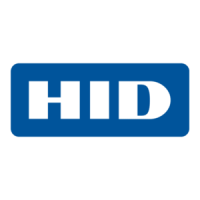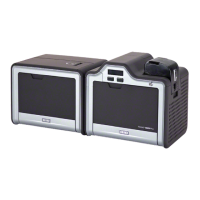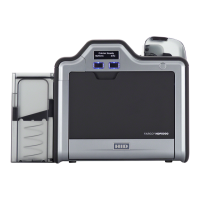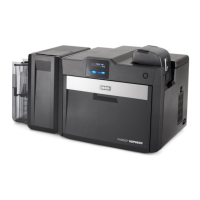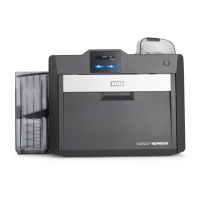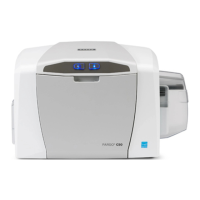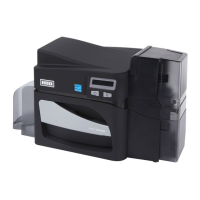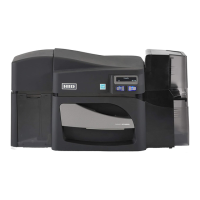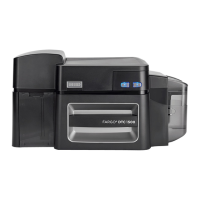What does invalid ribbon mean on HID Printer?
- ZzhartAug 30, 2025
If your HID Printer displays 'Invalid Ribbon', get the correct ribbon from your dealer.
What does invalid ribbon mean on HID Printer?
If your HID Printer displays 'Invalid Ribbon', get the correct ribbon from your dealer.
How to clear card jam in prox area of HID HDP5000 Printer?
To address a 'Card Jam: Prox' error on your HID Printer, clear the jam in the PROX card encoding area.
What causes system fault on HID HDP5000 Printer?
If an unspecified system error is detected by the printer firmware on your HID Printer, reset the printer and try again. If this problem persists, call for technical assistance.
What to do if HID HDP5000 says no smart card encoder?
If your HID Printer displays 'No Smart Card Encoder', click Cancel Print to cancel the current operation.
What to do when HID HDP5000 film is out?
If the HDP film has run out on your HID Printer, install a new roll of film and press Resume to continue or Cancel to reset.
How to fix E-Card Startup Error on HID HDP5000?
To resolve the 'E-Card Startup Error' on your HID Printer, reset the printer and try again. If the problem persists, call for technical assistance.
What to do if HID HDP5000 Printer says ejecting card?
If your HID Printer shows 'Ejecting Card', click OK to clear the message, as the card has already been ejected.
What causes headlift error on HID Printer?
If there is a problem with the printhead lift or transfer roller headlift on your HID Printer, reset the printer and try again. If this problem persists, call for technical assistance.
Why does HID HDP5000 Printer say invalid film?
If an unauthorized film is installed in the HID Printer, this message will appear. Get the correct Film from your dealer.
How to fix unable to feed card on HID HDP5000?
If your HID Printer is unable to feed a card, first check that there are cards in the cartridge. Then, make sure the cards aren't stuck together, jammed, or of the wrong thickness.
Describes the step-by-step process of the HDP5000 printer's operation.
Details the sequence of operations for a dual-sided, full-color print job with magnetic encoding.
Explains the sequence of operations for the Lamination Module after printing.
Critical instructions and warnings for safe printer operation and handling.
Lists the certifications and standards the printer complies with, such as CSA, FCC, and UL.
Specifies the range of card thicknesses supported for printing and lamination.
Provides the physical dimensions of the printer and its modules in inches and millimeters.
Details the print speed in seconds per card and cards per hour for various print configurations.
Explains the print method for sharp black text and barcodes using resin-based ink.
Describes the Printhead as the component that performs the actual printing and its fragility.
Details the two-line, 32-character LCD display used for printer status and softkey functions.
Explains the function of the two softkey buttons below the LCD, which change based on printer mode.
Lists accepted card types like UltraCard, PVC, PET, Proximity, and Magnetic Stripe cards.
Specifies standard CR80 card size and printing recommendations for card surfaces and design.
Describes the card cartridge capacity and its role in loading blank cards.
Details the capacity of the card output hopper and its functionality with a flipper module.
Explains that both the printer and its software driver control the built-in transfer roller.
Guides on adjusting the transfer roller temperature via the Printer Driver setup.
Discusses the types of overlaminates accepted, including their thickness and durability.
Explains the availability of clear, holographic, and custom designs for overlaminates.
Instructions for inspecting the printer carton for damage and ensuring all accessories are included.
Guidelines for selecting a suitable location with adequate air circulation and avoiding environmental hazards.
Step-by-step instructions for loading the print ribbon into the printer cartridge.
Detailed steps for loading the HDP transfer film into the film cartridge.
Instructions for loading blank cards into the card cartridge, specifying orientation.
Explains dye-sublimation as a method for smooth, continuous-tone images using dye-based ribbons.
Describes resin thermal transfer for sharp text and barcodes using resin-based ink.
Crucial safety information regarding electrostatic discharge and general handling precautions.
Overview of the HDP500 printer driver settings and available options.
Explains how to configure card size, type, and orientation within the printer driver.
Details the options for selecting CR-80 or custom card sizes, including print area dimensions.
Guides on choosing the appropriate card stock type from a list of supported options.
Describes the function for automatically detecting installed ribbons, film, and laminates.
Instructions for matching the Ribbon Type selection to the ribbon loaded in the printer.
Explains the functions for dual-sided printing, including printing both sides and specific panel splits.
Details how to control image properties like sharpness, contrast, gamma, and color balance.
Explains how to use the Advanced Image Color window for fine-tuning image appearance.
Guides on adjusting the horizontal and vertical position of the printed image on the card.
Explains how to control the speed and temperature for transferring images from film to card.
Describes how to specify the magnetic encoding standard to use (ISO, Custom, Raw Binary, JIS II).
Guides on selecting coercivity levels and magnetic tracks for encoding cards.
Details how to adjust the horizontal position of the overlaminate on the card.
Covers adjusting the lamination dwell time and selecting the type of lamination material used.
Explains how to set custom card sizes and define specific print areas for the K Panel.
Describes options for printing black ink with YMC panels or only black ink on specific backgrounds.
Provides information on the installed ribbon, HDP film, and laminate levels detected by the printer.
Instructions on how to use the security lock slot to prevent unauthorized removal of the printer.
Step-by-step guide for installing the optional Flipper Module accessory to the printer.
Troubleshooting tables that list LCD and printer error messages, their causes, and solutions.
Lists the necessary system requirements for using the Ethernet option, including network and PC specifications.
Describes network services like Print Server, Web Page Server, and Telnet Server for printer management.
Describes how to initiate a Telnet session for network administration and printer commands.
Provides an overview of the card lamination module and its capabilities for applying overlaminates.
Step-by-step guide for installing the lamination module and its driver software.
Instructions on how to adjust the card flattener to fine-tune the flatness of laminated cards.
Discusses optimizing HDP printing for various card stocks based on surface texture and cleanliness.
Explains how to perform a tape adhesion test to evaluate HDP film transfer quality.
Instructions on how to open the Toolbox window to access various printer configuration tabs.
Details how to select printer features, monitor events, and set the LCD display language.
Guides on adjusting internal printer settings customized at the factory, including restoring defaults.
Lists the necessary cleaning supplies, such as printhead cleaning swabs and cleaning cards.
Procedure for cleaning rollers to maintain print quality and prevent jams.
Instructions for cleaning the printhead to ensure consistent print quality, especially after ribbon changes.
Explains how to access the Diagnostics function within the Fargo Workbench utility via the Card tab.
Guides on using the Workbench utility to configure fluorescent panel data for security features.
Explains how to create fluorescent images using application software and text string commands.
Describes generating an Inhibit Panel layout using the Fargo Workbench Printer Utility.
Explains how print jobs are rendered and how inhibit areas affect the print output.
Provides information to help resolve issues encountered when using the inhibit panel functionality.
Instructions for cleaning and packing the card printer for transport, including module handling.
Guides on downloading and installing new firmware versions from the HID Global website.
Provides contact information for Fargo Technical Support via phone and web.
Instructions on how to read the printer's serial number to determine its manufacturing date.
Defines technical terms used throughout the manual for better understanding.
Describes the step-by-step process of the HDP5000 printer's operation.
Details the sequence of operations for a dual-sided, full-color print job with magnetic encoding.
Explains the sequence of operations for the Lamination Module after printing.
Critical instructions and warnings for safe printer operation and handling.
Lists the certifications and standards the printer complies with, such as CSA, FCC, and UL.
Specifies the range of card thicknesses supported for printing and lamination.
Provides the physical dimensions of the printer and its modules in inches and millimeters.
Details the print speed in seconds per card and cards per hour for various print configurations.
Explains the print method for sharp black text and barcodes using resin-based ink.
Describes the Printhead as the component that performs the actual printing and its fragility.
Details the two-line, 32-character LCD display used for printer status and softkey functions.
Explains the function of the two softkey buttons below the LCD, which change based on printer mode.
Lists accepted card types like UltraCard, PVC, PET, Proximity, and Magnetic Stripe cards.
Specifies standard CR80 card size and printing recommendations for card surfaces and design.
Describes the card cartridge capacity and its role in loading blank cards.
Details the capacity of the card output hopper and its functionality with a flipper module.
Explains that both the printer and its software driver control the built-in transfer roller.
Guides on adjusting the transfer roller temperature via the Printer Driver setup.
Discusses the types of overlaminates accepted, including their thickness and durability.
Explains the availability of clear, holographic, and custom designs for overlaminates.
Instructions for inspecting the printer carton for damage and ensuring all accessories are included.
Guidelines for selecting a suitable location with adequate air circulation and avoiding environmental hazards.
Step-by-step instructions for loading the print ribbon into the printer cartridge.
Detailed steps for loading the HDP transfer film into the film cartridge.
Instructions for loading blank cards into the card cartridge, specifying orientation.
Explains dye-sublimation as a method for smooth, continuous-tone images using dye-based ribbons.
Describes resin thermal transfer for sharp text and barcodes using resin-based ink.
Crucial safety information regarding electrostatic discharge and general handling precautions.
Overview of the HDP500 printer driver settings and available options.
Explains how to configure card size, type, and orientation within the printer driver.
Details the options for selecting CR-80 or custom card sizes, including print area dimensions.
Guides on choosing the appropriate card stock type from a list of supported options.
Describes the function for automatically detecting installed ribbons, film, and laminates.
Instructions for matching the Ribbon Type selection to the ribbon loaded in the printer.
Explains the functions for dual-sided printing, including printing both sides and specific panel splits.
Details how to control image properties like sharpness, contrast, gamma, and color balance.
Explains how to use the Advanced Image Color window for fine-tuning image appearance.
Guides on adjusting the horizontal and vertical position of the printed image on the card.
Explains how to control the speed and temperature for transferring images from film to card.
Describes how to specify the magnetic encoding standard to use (ISO, Custom, Raw Binary, JIS II).
Guides on selecting coercivity levels and magnetic tracks for encoding cards.
Details how to adjust the horizontal position of the overlaminate on the card.
Covers adjusting the lamination dwell time and selecting the type of lamination material used.
Explains how to set custom card sizes and define specific print areas for the K Panel.
Describes options for printing black ink with YMC panels or only black ink on specific backgrounds.
Provides information on the installed ribbon, HDP film, and laminate levels detected by the printer.
Instructions on how to use the security lock slot to prevent unauthorized removal of the printer.
Step-by-step guide for installing the optional Flipper Module accessory to the printer.
Troubleshooting tables that list LCD and printer error messages, their causes, and solutions.
Lists the necessary system requirements for using the Ethernet option, including network and PC specifications.
Describes network services like Print Server, Web Page Server, and Telnet Server for printer management.
Describes how to initiate a Telnet session for network administration and printer commands.
Provides an overview of the card lamination module and its capabilities for applying overlaminates.
Step-by-step guide for installing the lamination module and its driver software.
Instructions on how to adjust the card flattener to fine-tune the flatness of laminated cards.
Discusses optimizing HDP printing for various card stocks based on surface texture and cleanliness.
Explains how to perform a tape adhesion test to evaluate HDP film transfer quality.
Instructions on how to open the Toolbox window to access various printer configuration tabs.
Details how to select printer features, monitor events, and set the LCD display language.
Guides on adjusting internal printer settings customized at the factory, including restoring defaults.
Lists the necessary cleaning supplies, such as printhead cleaning swabs and cleaning cards.
Procedure for cleaning rollers to maintain print quality and prevent jams.
Instructions for cleaning the printhead to ensure consistent print quality, especially after ribbon changes.
Explains how to access the Diagnostics function within the Fargo Workbench utility via the Card tab.
Guides on using the Workbench utility to configure fluorescent panel data for security features.
Explains how to create fluorescent images using application software and text string commands.
Describes generating an Inhibit Panel layout using the Fargo Workbench Printer Utility.
Explains how print jobs are rendered and how inhibit areas affect the print output.
Provides information to help resolve issues encountered when using the inhibit panel functionality.
Instructions for cleaning and packing the card printer for transport, including module handling.
Guides on downloading and installing new firmware versions from the HID Global website.
Provides contact information for Fargo Technical Support via phone and web.
Instructions on how to read the printer's serial number to determine its manufacturing date.
Defines technical terms used throughout the manual for better understanding.
| Print Resolution | 300 dpi |
|---|---|
| Interface | USB |
| Print Technology | Dye sublimation |
| Card Capacity | 100-card input hopper |
| Connectivity | USB 2.0 |
| Print Capability | Single-sided |
| Operating System Support | Windows 7, 8, 10 |
| Card Sizes | CR80 (standard credit card size) |

